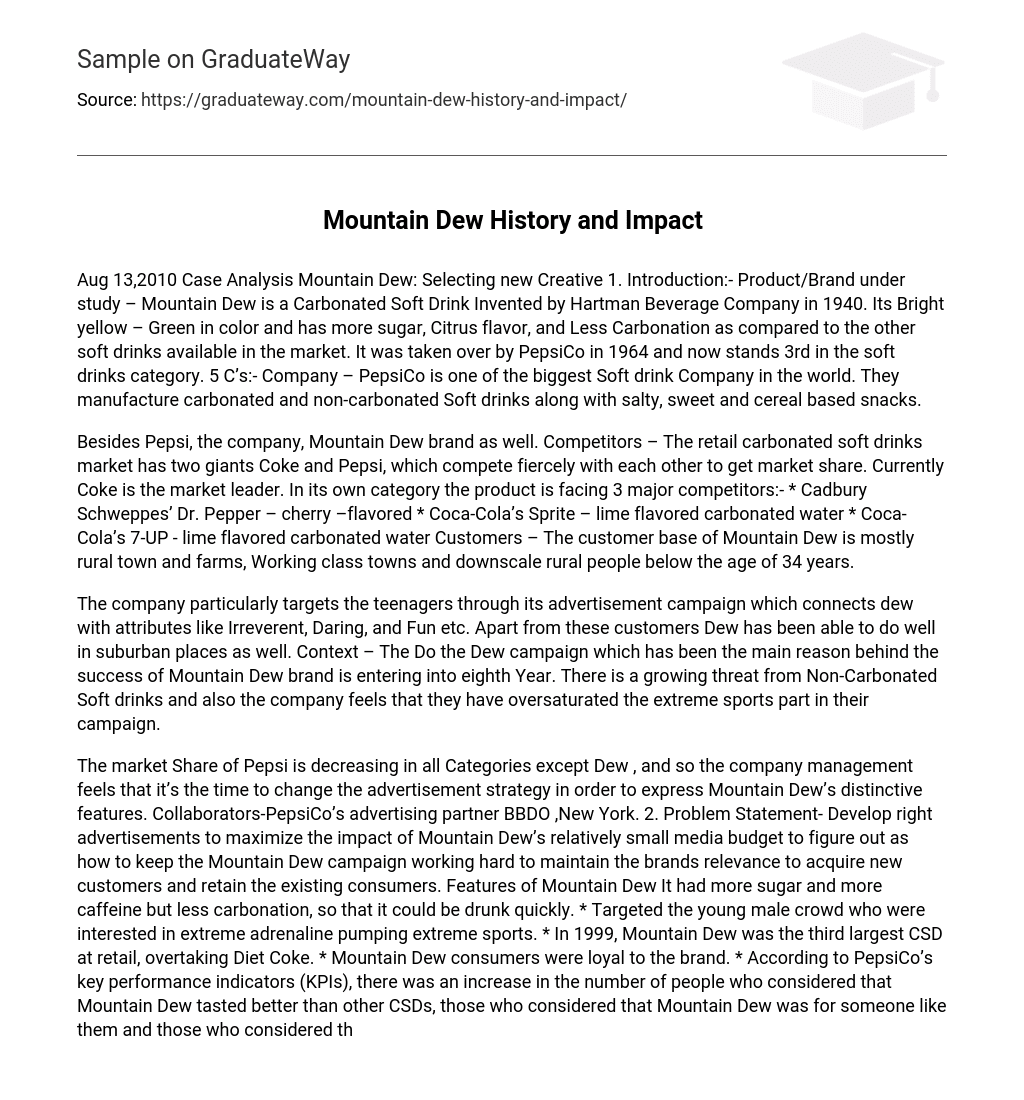Mountain Dew, a carbonated soft drink developed in 1940 by the Hartman Beverage Company, is renowned for its vibrant yellow-green hue and celebrated for its elevated sugar levels, citrusy taste, and comparatively lower level of carbonation in comparison to alternative beverages. In 1964, PepsiCo acquired Mountain Dew and it currently holds the position as the third most favored soda.
PepsiCo, a well-known global company in the soft drink sector, manufactures a wide range of beverages that include carbonated and non-carbonated drinks. They also provide various snacks such as salty treats, sweet treats, and cereal-based snacks.
Aside from Pepsi, the company also includes the brand Mountain Dew. In the retail carbonated soft drinks market, there are two major competitors competing fiercely for market share: Coke and Pepsi. Currently, Coke holds the top position in the market. However, within its specific product category, it faces three significant rivals:
- Cadbury Schweppes’ Dr. Pepper – cherry –flavored
- Coca-Cola’s Sprite – lime flavored carbonated water
- Coca-Cola’s 7-UP – lime flavored carbonated water
Mountain Dew primarily caters to customers residing in rural towns, farms, and working-class towns. These customers are typically below the age of 34 and are predominantly found in downscale rural areas. The company focuses its advertising campaign on teenagers, associating Mountain Dew with qualities such as irreverence, daring, and fun. In addition to these customer groups, Mountain Dew has also found success in suburban areas.
Context – The Do the Dew campaign, which has been the primary driver of Mountain Dew brand’s success, is now in its eighth year. The company acknowledges a growing threat from Non-Carbonated Soft drinks and also recognizes that they have saturated the extreme sports aspect of their campaign.
Pepsi’s market share is declining in all categories, except for Dew. Therefore, the company’s management believes it is necessary to modify the advertising strategy to highlight the unique characteristics of Mountain Dew. Collaborators in this endeavor include PepsiCo’s advertising partner, BBDO in New York.
Develop effective advertisements to maximize the impact of Mountain Dew’s limited media budget in order to maintain the brand’s relevance, attract new customers, and retain existing consumers. The distinct features of Mountain Dew include higher sugar and caffeine content, coupled with lower carbonation for fast consumption. The advertising efforts primarily target young males with a penchant for extreme sports and adrenaline-filled activities.
In 1999, Mountain Dew surpassed Diet Coke at retail to become the third largest CSD. The brand enjoyed a strong following, as indicated by PepsiCo’s key performance indicators (KPIs). These KPIs showed an increase in the number of people who preferred the taste of Mountain Dew over other CSDs, identified with the brand’s target audience, and associated Mountain Dew drinkers with being ‘cool’. The ‘Do the Dew’ campaign prominently featured the Dew Dudes in all advertisements until 1997.
Mountain Dew chose to rely on the creativity of their advertisements to increase their sales and profits, despite their competitors increasing their advertisement budgets. The emergence of non-carbonated alternatives such as Gatorade, bottled water, Snapple, Arizona, Red Bull, and SoBe posed a challenge for Mountain Dew. The decline in consumption of carbonated beverages was due to consumers’ increased concern about their health. There were industry rumors suggesting that Coca-Cola, Annheuser-Busch, and Cadbury Schweppes were actively working on developing functional drinks. Additionally, there was a growing skepticism among young consumers towards large corporations and exaggerated products.
In 1999, sales of Carbonated Soft Drinks were negatively affected by a 5% increase in retail prices, leading to customer dissatisfaction. During the 1990s, Mountain Dew attempted to engage consumers through the use of musicians and celebrities in its advertisements, but this approach failed to make a significant impact. As early as 1998, managers at PepsiCo expressed concerns that the advertisements had become overly predictable and that the use of alternative sports was losing its effectiveness due to excessive exposure. Among carbonated soft drinks, Mountain Dew had the strongest opposition from parents who made concerted efforts to prevent their children from consuming it. PepsiCo managers were still searching for a reliable research method that could provide accurate assessments of advertising effectiveness.
Mountain Dew had significantly less market penetration among the overall population. To break away from their monotonous advertising campaign, the company is assessing various advertisements to kickstart a new marketing campaign that will attract consumers. The following are the pros and cons of each advertisement.





